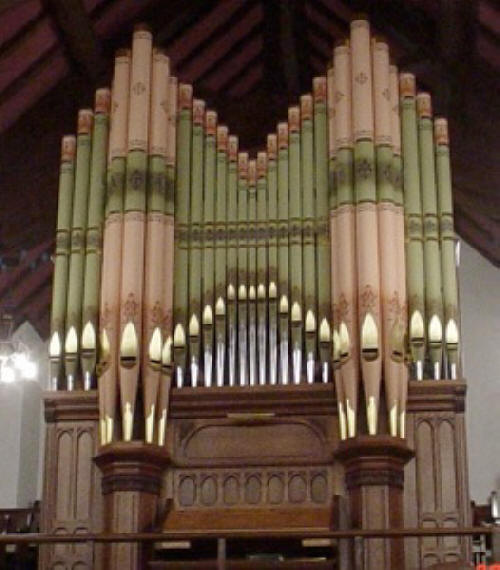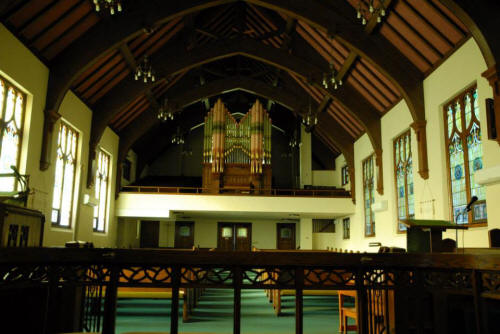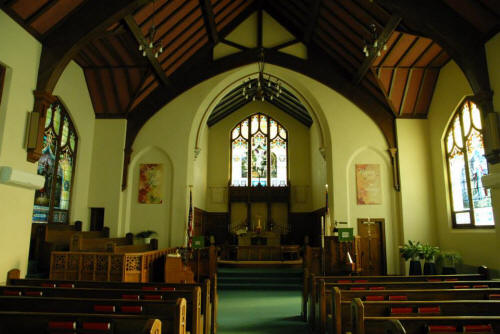|
Builder: Hinners Organ Co, Opus 556, 1903 Rutz Organ Co, 2003 Ranks: 9 Action: Mechanical Notes:Information and photos from church website and Facebook, 2009/2020. On September 23, 1903, a contract was executed between the Hinners Organ Company of Pekin, Illinois, and the LeSueur River Lutheran Church of New Richland, Minnesota, for the purchase of a nine-rank, two-manual organ at a cost of $1,012.00, payable 30 days after installation of the instrument. The contract was signed by four members of the congregation: Reverend O. A. Melby, P. O. Sunde, S. O. Thurson, C. B. Johnson; and A. W. Hinners, secretary of the Hinners Organ Company. The contract also included the catalog illustration of the instrument being purchased. The instrument was intended for use in the “town” church that was part of the LeSueur River congregation, since the “country” church already owned a one-manual, six-rank Barckhoff tracker organ. Less than three months later, the instrument was installed on December 5, 1903, in the Norwegian Evangelical Lutheran Church of Waseca County. (The date and the signature of Thad. Muehlenbrink, the Hinners Organ Company representative who oversaw the installation, were found inside the swell box when the organ was disassembled.) The contract specified that it be installed “ at an angle in the front of the church.” Twenty years later, in September of 1923, the instrument was relocated to the present Trinity Lutheran Church building at a cost of $85.85. H. R. Leland of Forest City, Iowa, who was an employee of Thorwald Thorson, the architect who had drawn the plans and overseen the construction of the new Trinity Church building, accomplished the move. The charges were: 101 hours labor @ $.80 per hour, railroad fare of $3.80, and cash for screws, etc. in the amount of $1.25. For the next 80 years, until June of 2003, the instrument resided in the small, heavily enclosed organ room adjacent to the chancel. It was so cramped for space that some of the beautifully painted façade pipes were touching the walls and became severely damaged from repeated vibration against the plaster. Tuning and repairs were extremely difficult, since the only access to the instrument was through a small opening in the back of the instrument or by removal of the wooden chancel wall. Wooden latticework and fabric covered the pipes. Over the years, maintenance and repairs that were done included releathering the air reservoir and cleaning. The years took their toll, however, on the leather and felt washers, the wind chest, and the tracker action, as well as the pipes. The limited access to the instrument necessitated the use of aluminum foil and duct tape in some instances for tuning and repair. In recent years it was not unusual for the organist to remove a panel from just above the pedal board or keys during the course of a worship service, make a quick adjustment and then continue the service. In the late fall of 2002, a congregational meeting was held to determine the fate of Hinners 556. When posed with the choice of replacing the instrument with an electric organ or rebuilding and restoring the Hinners, we chose the Hinners. Rutz Organ Company was hired to do the restoration. On June 27, 2003, the instrument was disassembled, numbered and crated by Rutz employees and numerous members of the Trinity congregation, in much the same manner as employed by the Hinners Company in 1903 when it was installed. In 2003, however, the method of transportation to the Rutz Organ Company, of Morristown, Minnesota, was a Peterbilt truck and trailer, and not by train. Over the course of the next six months, Hinners 556 was reborn. Since most of the original casework was lost when the instrument was moved in 1923, the façade and casework were replaced with Hinners casework from another 1903 instrument. The façade or painted pipes were also replaced, due to extensive damage to the originals when they were moved and when the instrument was played, but these, too, are Hinners pipes with the painting, color and design a nearly exact duplication of the originals. The following information is from Rolland R. Rutz, CEO of Rutz Organ Company. “The instrument itself consists of nine ranks of pipes on two manuals (keyboards) and pedal. The instrument is completely mechanical action with the only modification being the addition of an electric blower. The hand pumping mechanism has been rebuilt and continues to function. The sound qualities of the organ are exactly as it was 100 years ago, with no modifications. The move to the balcony location has allowed it to have a much greater tonal presence because it is now a freestanding instrument and not heavily enclosed as in the chancel location. Also, it is much easier to do adjustments to the mechanism, and tuning is much easier in the new location.” On December 5, 2003, the Hinners 556 came home to Trinity, once again with the help of numerous members of the congregation. The road to completion proved bumpy in spots due to the nature of a tracker organ. Many adjustments have been made over the course of the last two months. The biggest bump came when we learned that it would be necessary to purchase a new blower for the instrument. This was necessitated by the fact that the blower had previously been located in the basement just below the organ in its chancel location. When the instrument moved to the balcony, a specially built soundproof box enclosed the blower. However, the amount of baffling necessary to insure quiet operation caused so much resistance to the airflow that the blower could no long provide sufficient power. The one-half horsepower blower has been replaced with a three-quarter horsepower blower, and Hinners 556 has finally realized its full potential. Today we are rededicating and celebrating this instrument and its role in our worship and praise. Johann Sebastian Bach, the great Lutheran composer and the most renowned organist of his time, declared, “the organ is my pulpit.” Many of his music manuscripts begin with the notation “JJ”, which stood for the Latin words for “Jesus, help me,” and end with the notation “SDG”, which stood for the Latin words for “to the glory of God alone.” May Jesus help us to glorify and worship God with our Hinners pipe organ for the next hundred years and beyond! A Brief History of the Hinners Organ Co. (Paraphrased from A History of the Hinners Organ Company of Pekin, Illinois by Allison Alcorn-Oppedahl, published in The Tracker, Journal of the Organ Historical Society, Volume 44, Number 3, 2000 John L. Hinners founded the Hinners Organ Company in 1879. His father, Peter, was a skilled church builder, and the Hinners family was a musical household. John was reared “with a hammer in his hands and his feet on the pedals,” learning skills of building and music that he would later combine into a business that produced nearly 3,000 pipe organs and 20,000 reed organs in its 55 years of existence. John Hinners spent the first ten years in business building reed organs. The skills and understanding he honed while building reed organs, namely compactness, mechanical reliability and superb cabinetry, as well as rigidly controlling variations, were later applied to pipe organ construction, which allowed him to offer quality instruments at lower prices. The Hinners Organ Company had no salesmen, but simply sent out catalogues listing standard instruments, which was another important factor in their ability to keep prices low enough so that small, rural congregations could afford a quality pipe organ. |
 |
 |
|
 |
|
 |
|
|
Standard shipping and delivery of the instruments was done by rail. Pipes and components were numbered, wrapped, and crated. Upon arrival at its destination, church members picked up the crates and waited for the Hinners representative to arrive and direct installation. The numbering system made installation quick and relatively easy, and usually required only one company representative. This representative's signature and the installation date is often found penciled somewhere inside the instrument. The Hinners Organ Company business peaked in 1912, when they employed 97 workers and shipped three organs a week. The turning point for the company came in 1930, when the effects of the Great Depression and misrepresentation of the company’s financial status by Hielo Rust, the company’s treasurer (who wanted to quit the firm and asked Arthur Hinners to buy his shares) brought about the end. The company closed its doors in 1936. “The Hinners Organ Company supplied a unique need in American society that arose from circumstances peculiar to the American situation. The frontier was closed and settlements were progressing beyond concern for mere survival to concerns for improving their quality of life. Raised in small fledgling churches around the Midwest, John L. Hinners felt the people’s desire for a pipe organ and understood their frustration with the expense and complexity of the instrument that made it impractical for small rural churches. In a creative combination of business methods and comprehension of musical and construction issues, the Hinners Organ Company brought pipe organs to rural America and filled the plains with music.” |